The Allnutts of Cheltenham
Since the 1880s four generations of Allnutts have been residents of Cheltenham. When in 1857 Joseph Allnutt at twenty seven years of age came on the Grand Trianon with his wife Matilda to the colony of Victoria they settled in East Brighton growing vegetables and herbs. It was there that George Thomas Allnutt was born.
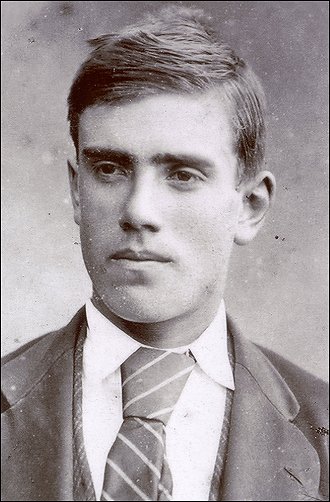
George Thomas Allnutt at sixteen years of age. Courtesy Dorothy Allnutt.
At twenty one years of age George was working on the construction of the railway line from Caulfield to Mordialloc carting gravel. This was a profitable business as it allowed him to accumulate sufficient funds to purchase twelve acres of land in Centre Dandenong Road, Cheltenham in 1884; two acres of which had been cleared but the remainder was predominantly ti-tree scrub with low sandy rises. Over the next twenty five years he added other properties until he owned one hundred and twenty acres of land in an irregular shape from the Centre Dandenong Road, Warrigal Road corner down as far as the Mentone Race Course. It was on this land that he built a house and named it Trianon after the ship on which his parents journeyed to Victoria, grew vegetables, milked cows, raised cattle and bred horses. He was a dairyman, horse dealer and a keen judge of horse flesh, carrier, cattleman, market gardener and inventor. His grandson, Len Allnutt commented that his grandfather “never let the grass grow under his feet working long hours and employing gangs of men in some of his activities.” [1]
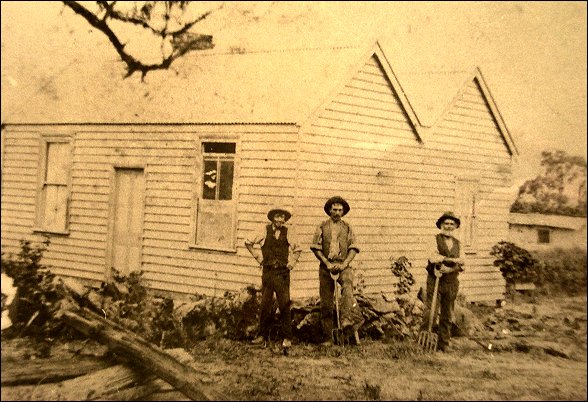
Original Allnutt home in Centre Dandenong Road, Cheltenham. Joseph Allnutt (left) George Allnutt (centre) other person unknown. Courtesy Len Allnutt.
Initially on arrival in Cheltenham, George cleared the block and started to breed and milk Jersey cattle. The milk was placed in cans and transported twice a day to the Cheltenham railway station on two wheeled ‘spring carts’ . The cans would be unloaded at a landing stage and when the train arrived the porter would use a hand trolley to move the milk to the guard’s van. From Cheltenham the milk was distributed to customers further up the line. In summer time, Len said, wet bags were placed over the cans to keep them cool, as there was no refrigeration in those days. [2]
After milking the cows the cream was separated from the milk and sent to a butter factory. At first this arrangement worked satisfactorily but later the dairymen felt there were discrepancies between quantities they thought they sent to the factory and what the factory claimed they received. A disgruntled group of farmers, with George Allnutt a leading member, decided to form their own co-operative to process their cream. The butter factory was established in Centre Dandenong Road with a manager to oversee the operation. [3]
Butter at that time was sold to grocers in a fifty six pound wooden box. The task of the individual grocer was then to cut it up into the one hundred and twelve half pounds for sale to his customers. Rarely, if ever, was this outcome achieved. Something was wrong! George Allnutt worked on the problem and designed an instrument consisting of a series of horizontal and vertical wires which when forced down over block of butter cut half pounds without wastage. The invention was patented and called the Invicta. Later George sold the patent but according to his grandson, received royalties from it for over thirty years.
As a cartage contractor G T Allnutt relied heavily upon horses so soon he was buying and breeding them for his own use and for others. Len said his grandfather was a very big horse dealer. He would travel all over Victoria and up to the Riverina buying horses from the breeders to bring them back to his property to break them in. At that time horses were critical to the life of the community being a major source of power. There were light delivery horses used by butchers, bakers and other tradesmen, hacks used by families in jinkers and sulkies, and heavy working horses for use on farms and in pulling heavily laden wagons. Allnutt traded them all, guaranteeing the quality of the horses he sold to nightsoil contractors, city carriers, brick carters, bakers, butchers and the general public. Family members said George would never miss the horse sales at Dandenong on a Saturday, and occasionally he would attend sales in Melbourne but many of his own sales would result from a telephone call. “I’ve got a horse that has gone lame, have you got one to suit me” was a typical request. His grandson, Len Allnutt thought his grandfather did quite well from the horse dealing and the contract carting despite the tough times when the banks failed and market gardeners were struggling to make a living. [4]
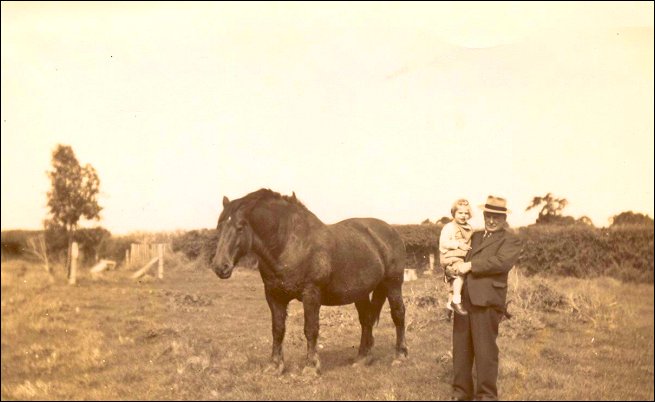
John Allnutt with horse Ginger and granddaughter Beverley on the Allnutt property at Cheltenham. Ginger was of the Suffolk breed and had been a sire champion at the Royal Melbourne Show.
With his interest in breeding, buying and selling horses, and his market gardening activities, it was only natural that he should be involved in the organization of the local agricultural show held on the Cheltenham recreational ground. A keen judge of horse flesh, he was called to judge in many shows on the Mornington Peninsula and in Gippsland but he never did this at Cheltenham because he was a member of the organising committee. Beside the show, he was also a keen participant in the Gala Day activity as a parade marshal. Members of the various lodges – the Oddfellows, the Australian Natives, the Rechabites, the Protestant Alliance, Druids and others would form a procession of floats down Point Nepean Road from Moorabbin to Cheltenham accompanied by lodge members wearing regalia. Prizes were awarded for the best floats. G T Allnutt would lead the parade, a significant community event, on horseback wearing his plumed cocked hat. The parade continued until after the First World War.
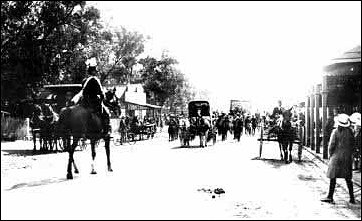
G T Allnutt as parade marshall on his horse in Charman Road, Cheltenham. Courtesy Moorabbin Historical Society.
Eighteen months after his arrival in Cheltenham he married Josephine Cameron at Eddington near Maryborough in the home of the bride’s parents. [5] After the wedding they returned to Cheltenham to live and joined the small Wesleyan church built on land given by Stephen Charman on Balcombe Road. This was before the congregation moved to the corner of Charman and Reserve roads, and subsequently to its most recent location in Charman Road, opposite the Youth Club. On that site it later became the Charman Uniting Church.
When the decision was made to build a new Methodist Church in Charman Road the idea was to construct it in weatherboard. George Allnutt challenged this decision, arguing it should be brick despite the prevailing view that the church could not afford it. According to Len Allnutt, his grandfather said ,”If you build in weatherboard, its not going to last long. If you build in brick it will be there when you and I have gone up over the railway line,” referring to the cemetery. [6] Showing his commitment he offered to double his contribution to the building fund. Subsequently a meeting of the congregation was called to review the situation and the conclusion was reached to build in brick. The foundation stone was laid by Mrs Woff and the new church was opened in 1922.
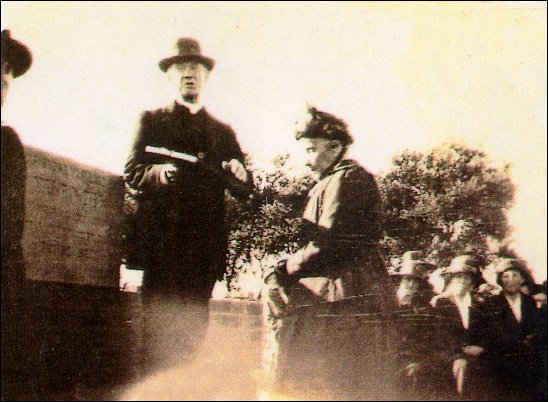
Mrs (Grandma) Woff laying the foundation stone of the Methodist Church in Charman Road, Cheltenham 1921. Courtesy Clarice Whitehead.
Both George’s son and grandson made strong commitment as trustees to the same Methodist church. John William, born in the Allnutt house in Centre Dandenong Road on September 2, 1887, became a trustee of the church when he was 21 years old and remained in that position of responsibility until his death in 1967. For twelve years he was the leader of the Bible class as well as undertaking other roles in the parish. At the time of his death he was described by the Rev Coulthard as a “man of strong convictions who believed in no compromise with evil in the social life of the community.” [7]
With the outbreak of the First World War in 1914 John enlisted in the Australian army in August 1915 joining the 23rd Battalion. He sailed to Egypt on the Cslerley and subsequently was posted to France where he saw action and was wounded when a bullet shattered his ankle. After a stay in a hospital in England he was repatriated home returning on the Themistocles on July 2, 1917. For a while, Len said, he father was disillusioned, he had lost some close friends in the conflict, and like many other returning soldiers had trouble settling down to civilian live. But unlike many of them he was able to resume his work as a cartage contractor with the support of his father so he didn’t have to battle like others.
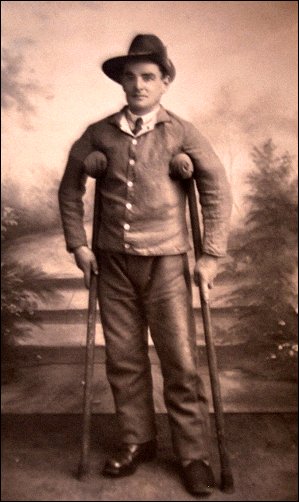
John Allnutt on crutches at a hospital in England after being wounded in France, 1916. Courtesy Dorothy and Len Allnutt.
It was Mickey Clements, a shire councillor, who first suggested to John Allnutt that he should stand at a council election. John’s experience of public life was limited to his work at the church and his involvement in the formation of the Cheltenham Moorabbin sub branch of the RSL so at first he was reluctant. Nevertheless, out of his war experiences and a conviction that he should be contributing to the welfare of his community he relented.
John Allnutt became a member of the Shire of Moorabbin on September 5, 1927, and remained a councillor, unopposed in subsequent elections until August 15, 1949 when he retired due to ill-health. He was president of the shire in 1930 and mayor of the City of Moorabbin in 1936 and 1948. During his terms of office the municipality of Moorabbin moved from a largely rural environment to one where manufacturing industries were being introduced. He is credited with playing a significant role in convincing British Xylonite and Gilbey’s Gin to establish themselves in Moorabbin. Not only did these companies provide employment to residents in the municipality they also paid a higher level of local government rates than was gained from land used for agricultural purposes. With more money flowing to the municipal’s coffers the council was in a better position to provide the needed infra structure for the area to progress. Nevertheless, according to Len, the achievement that gave his father the greatest pleasure was the building of the Mordialloc – Cheltenham hospital.

John Allnutt President Shire of Moorabbin 1930-31, Mayor of City of Moorabbin 1936-37, 1948-49.
For many years the district was served by small private hospitals often owned and operated by individual nursing sisters with the support and cooperation of local doctors. Shalimar, in Charman Road, conducted by Sisters Woff and Barrow in the 1930s was one example, as well as Merleswood and Strathaven in Mentone. With the Depression of the 30s many of these hospitals closed down forcing expectant mothers, those requiring urgent operations and the aged to find accommodation elsewhere. This generated a concern amongst members of the community and a drive to establish a local public hospital was begun. John Allnutt was part of this movement.
In May 1938 a group of men and women representing various interests met at the home of W C Courtney, the manager of the Cheltenham Dispensary, to discuss the need for a hospital. The three Cheltenham Ward councillors were present as were doctors Bernard Hudson and Keith Stephenson. [8] John Allnutt was elected chairman of the meeting with John Whitehead acting as secretary., The initial task identified by the group was to establish where financial help was available.
When it was discovered that no financial assistance was to be had from the Bush Nursing Association a public meeting was called for June 8, 1938 in the Cheltenham Mechanics’ Institute. Overwhelming support was given to the proposal to build a hospital. A committee was formed and John Allnutt was elected president. [9]
Discovering the existence of a similar movement working for the establishment of a hospital in the City of Mordialloc, the Cheltenham group joined forces with Mordialloc in an effort to gain support for one community hospital. John Allnutt was appointed President of the combined committee with Cr McCully of Mordialloc as Secretary.
Raising the community financial contribution to establish the hospital was an extremely difficult task in the face of vague commitments of the State government. Finally, the government granted a permit to do the preliminary planning and on September 13, 1950 John Allnutt, as Chairman of the Committee of Management welcomed The Governor of Victoria, Sir Dallas Brooks to the laying of the foundation stone. This vice regal visit inspired renewed activity to raise the community’s contribution to the building fund and ultimately the hospital became a reality on March 7, 1953. John Allnutt became the first President of the Management Committee and remained a member almost up to the time of his death in January 1967. [10]. The Allnutt association with the hospital was taken up later by John’s son, Len who served on the committee of management for nineteen years from 1975, and like his father, for three of those years he was President.
Throughout his life John Allnutt was a keen participant in sport, as a player, committee member and spectator. Prior to enlisting to fight the Germans in France John was a team player of the Cheltenham Football Club and on his return was an active committee member for many years. Because of war injuries he was not able to be a player but he was an enthusiastic spectator well into the later years of his life despite deteriorating eye sight. At matches Percy Woff and Frank Biehl would provide the running commentary of the actions on the field for his benefit and enjoyment. This love of football saw him taking on the role of president of the club from as well as being president of the Federal Football League from 1935 to 1938. The Federal League named their best and fairest trophy the Allnutt trophy in his honor.
John Allnutt also served as a president of the Cheltenham Bowling Club. He joined the club at its inception in 1906. In 1948 the club moved from its location in Hornsby Road to its present site on the corner of Wilson Street and Centre Dandenong Road; to one and a half acres of land purchased from John Allnutt for the nominal price of £750. Later the club increased the area to two acres with an additional purchase. [11]
For the last eleven years of his life, John Allnutt suffered from blindness. This disability was attributed to an incident that occurred one night in August, 1945 when he was on the way to a council meeting. The railway gates on Point Nepean Road at Moorabbin were closed to allow the passage of a train. John ‘s car was stationery behind the loaded truck of a fellow councillor and market gardener. This truck was loaded with cauliflowers, as the plan was to proceed to the Victoria market after the conclusion of the council meeting. John saw three young men pulling vegetables from the truck, endangering the stability of the whole load. He got out to warn the driver and accosted the youths only to have them turn upon him. In the scuffle he received kicks to the head. While this was happening the train had passed, the gates were opened and the councillor proceeded to the meeting unaware of the difficult situation John Allnutt was in. The youths were never caught but John suffered the consequences of their criminal behaviour.
John Allnutt died suddenly at home on January 10, 1967, his death being noted on the front page of the Moorabbin News ,”John Allnutt shed light for many”. The newspaper report described him as a civic leader, a churchman, a soldier and a fine sportsman. “He was all of those things … But many remembered him best as the man who continued to ‘let his light shine before men’ even though the last 11 years of his life were spent in darkness. [12] He was buried in the Cheltenham Pioneers’ Cemetery.
Footnotes
- White, P., Talking with Piri, 2001.
- Whitehead, G., Interview with Len Allnutt 2002.
- Len Allnutt indicated that the butter factory was built on a section land formerly owned by his grandfather, today it would approximate to 178 –180 Centre Dandenong Road. “That was sufficient land because it was not a big concern,” reported Len when interviewed in 2002.
- Whitehead, G., Interview with Len Allnutt, 2002.
- Birth Deaths & Marriages. Josephine’s parents had travelled on the Grand Trianon from England with George’s parents and had maintained their friendship on arrival in Victoria.
- Whitehead, G., Interview with Len Allnutt, 2002.
- Moorabbin News, January 18, 1967.
- Others present were: Pastor Allan, Messrs. Lyndon, Charlton, Needell, Wilson, Courtney and Whitehead. Mesdames Courtney and Doward.
- Members of the committee – Cr Le Page, Cr Allnutt, Messrs Lyndon, Charlton, Courtney, Smith, Hornibrook, Young, Needell, Brown, Whitehead, Tilley, Wilson, Aitken, McKelvie, Squire, Day Rowe, Pastor Allan and Mesdames Courtney, Wilden, Weeks, Young, Marshall, Margetson, Doward, Richards, Howard and Gardner.
- John Allnutt resigned from the committee on November 21, 1956 due to ill health.
- Moorabbin Standard News, September 13, 1983.
- Moorabbin News, January 18, 1967.
